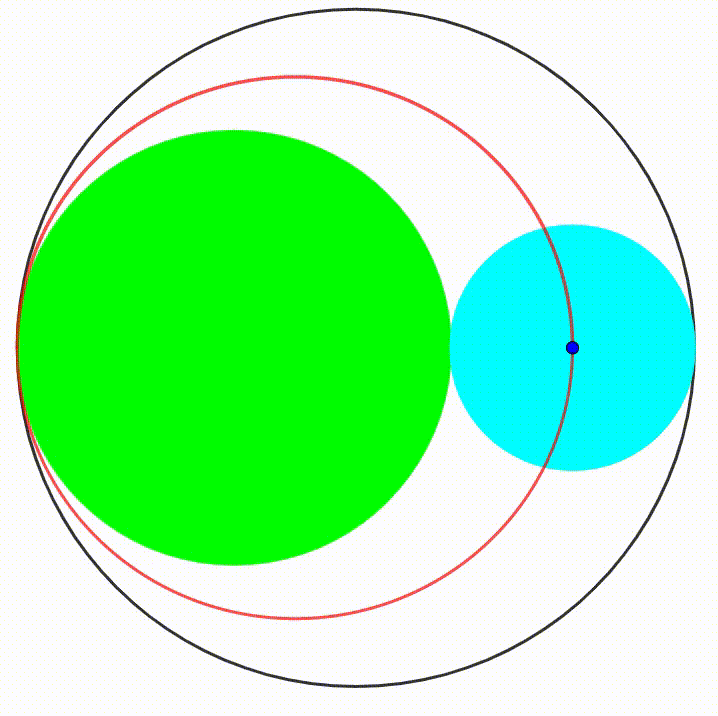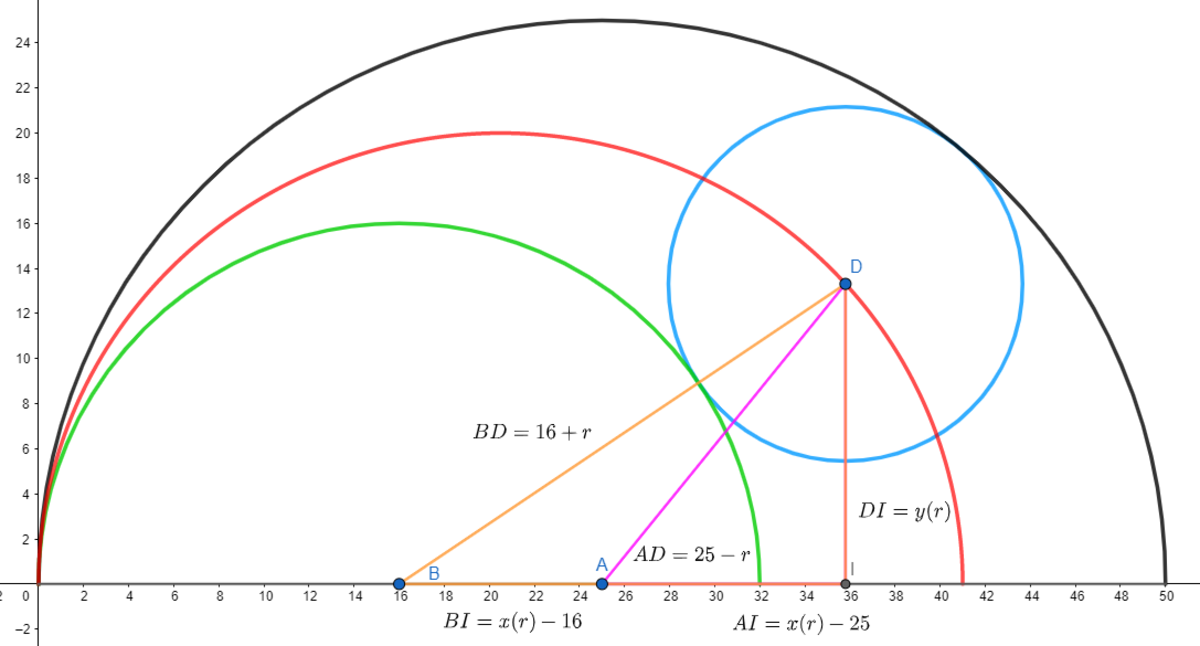Dynamic Geometry: P24
 The diagram shows a black circle with radius
2
5
and a green circle with radius
1
6
which is internally tangent to the
black circle. The cyan circles are freely moving so that they are tangent to the green circle and to the black circle at any moment. The center of the cyan circle traces a
locus
(red curve). The area bounded by the red curves can be expressed as
a
π
where
a
is a positive integer. What is
a
?
The diagram shows a black circle with radius
2
5
and a green circle with radius
1
6
which is internally tangent to the
black circle. The cyan circles are freely moving so that they are tangent to the green circle and to the black circle at any moment. The center of the cyan circle traces a
locus
(red curve). The area bounded by the red curves can be expressed as
a
π
where
a
is a positive integer. What is
a
?
The answer is 410.
This section requires Javascript.
You are seeing this because something didn't load right. We suggest you, (a) try
refreshing the page, (b) enabling javascript if it is disabled on your browser and,
finally, (c)
loading the
non-javascript version of this page
. We're sorry about the hassle.
2 solutions
 - Let us choose an arbitrary circle tangent to the green semicircle and tangent internally to the black circle. Its radius is
r
and its center is
D
(
x
(
r
)
;
y
(
r
)
)
- Let us choose an arbitrary circle tangent to the green semicircle and tangent internally to the black circle. Its radius is
r
and its center is
D
(
x
(
r
)
;
y
(
r
)
)
-
We shall use the pythagorean theorem to write two equalities :
-
{ ( 1 6 + r ) 2 = y ( r ) 2 + ( x ( r ) − 1 6 ) 2 ( 2 5 − r ) 2 = y ( r ) 2 + ( x ( r ) − 2 5 ) 2
-
This allows us to find the system of parametric equation expressing the x -coordinate and y -coordinate in terms of r :
-
⎩ ⎪ ⎨ ⎪ ⎧ x ( r ) = 9 4 1 r y ( r ) = 9 4 0 ( 9 − r ) r
-
Finally we can then express y in terms of x to get the equation of the locus: y = 4 1 4 0 4 1 x − x 2
-
Now we can calculate the required area: 2 ⋅ ∫ 0 4 1 4 1 4 0 4 1 x − x 2 = 4 1 0 π
-
The answer is then 4 1 0
Let the center of the big circle be O ( 0 , 0 ) , the origin of the x y -plane. Then the center of the green circle is Q ( − 9 , 0 ) . Let any point (or the center of the cyan circle with radius r ) on the locus be P . Then we note O , P , the tangent point of the big circle are colinear and that O P = 2 5 − r . Also P Q = 1 6 − r . Then O P + P Q = 2 5 − r + 1 6 + r = 4 1 for any point P on the locus. Therefore the locus is an ellipse with O and Q being the foci.
Let the vertices of the ellipse be A and B , and its center C . Then A = ( − 2 5 , 0 ) , B = ( 1 6 , 0 ) , and C = ( − 4 . 5 , 0 ) . The semi-major axis a = 2 2 5 + 1 6 = 2 0 . 5 and semi-minor axis b = a 2 − c 2 = 2 0 . 5 2 − 4 . 5 2 = 2 0 , where c is the distance between the center and a focus. Then the area of the ellipse is a b π = 2 0 . 5 ⋅ 2 0 π = 4 1 0 π .